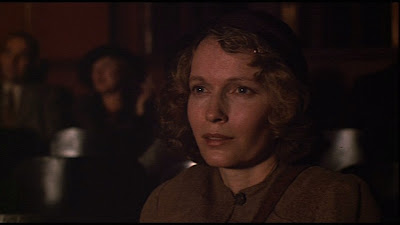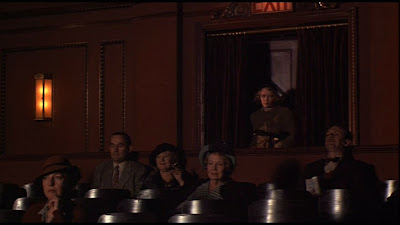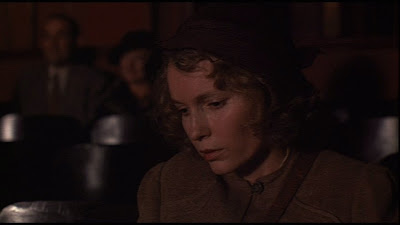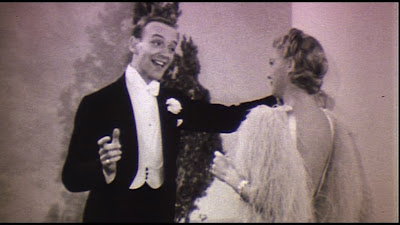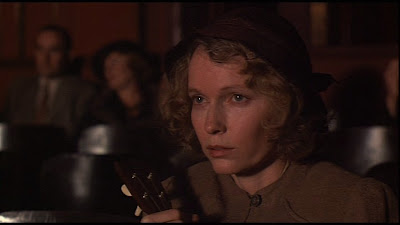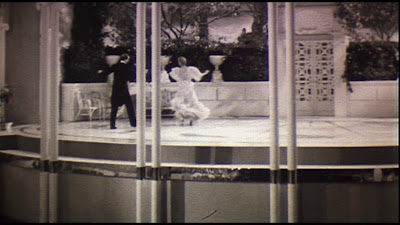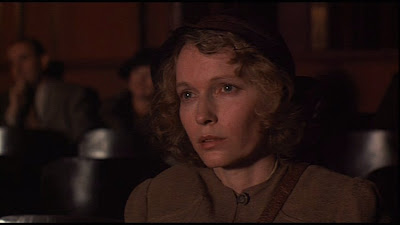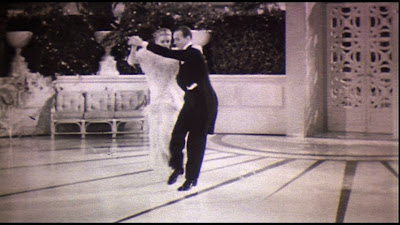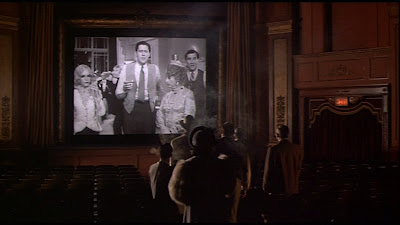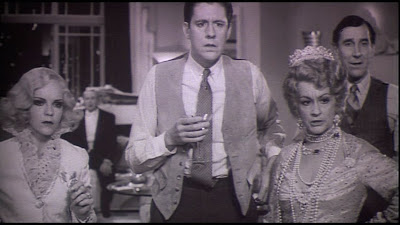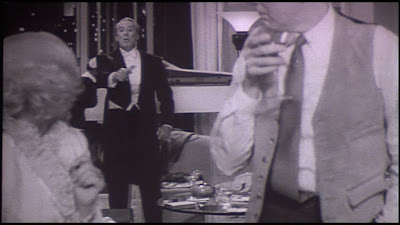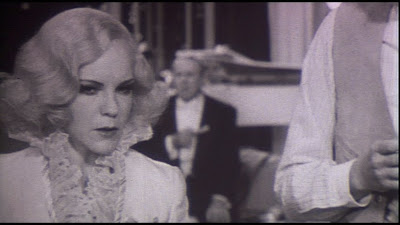This post is my contribution to the Close-Up Blog-a-thon hosted by Matt Zoller Seitz at his blog, The House Next Door.
Warning: There be spoilers here.
The Purple Rose of Cairo (1985) concludes with a close-up — indeed, arguably, an exchange of close-ups — that brings Woody Allen’s finest film to an interesting and ambiguous end.
The movie is set in New Jersey during the Great Depression, and it concerns a woman named Cecilia (Mia Farrow) who frequently escapes from her dreary job and her abusive, cheating husband by going to the movies. Indeed, she loves movies so much that, one day, a character named Tom Baxter (Jeff Daniels) steps right off the movie screen to be with her. This sends the people who made the movie into a panic; if Tom were to commit any crimes while running around in the real world, the studio that created him and the movie in which he appears might be held responsible.
Gil Shepherd (also Daniels), the actor who played Tom, comes to New Jersey and woos Cecilia away from Tom by promising to take her away with him to Hollywood. Cecilia, believing that Gil represents the “real world” while Tom is only imaginary, falls for this and breaks up with Tom. Tom, heartbroken, returns to the movie that he had left — presumably unaware that the studio will destroy all copies of the film once he is back on the screen, to ensure that something like this never happens again.
Cecilia goes home to pack her bags, tells her husband she is going to Hollywood, and runs to the movie theatre to meet Gil. But there, she learns that Gil has already left, and left her behind. Her “real world” solution was, itself, an illusion. Saddened, she does what she always does: she steps into the movie theatre — where she watches the scene from Top Hat (1935) in which Fred Astaire sings ‘Cheek to Cheek’ while dancing with Ginger Rogers.
And there, Cecilia falls in love with the movies all over again.
The scene hinges entirely on the subtle transformation in Cecilia’s face as she watches Top Hat. When she enters the theatre, at the back of a long-ish shot, she is pretty sad and dejected. Within that same shot, she walks down the aisle until she is fairly close to the camera, at which point she picks a seat and settles into it. The rest of the scene is shot from this angle, looking at Cecilia’s face.
Or is it? I said above that this scene is an exchange of close-ups, and what I mean by that is that the scene alternates between Cecilia’s face and the movie that she is watching. But Woody did not shoot Top Hat himself; surely he is just splicing in archival footage here? And the clips we see consist entirely of medium or long shots; in what sense can they be called “close-ups”?
The answer lies in the fact that, throughout this film, Woody has used a mixture of angles when depicting the moviegoers and their relationship to the movies that they are watching. Consider the shots below, taken from the scene where Gil and the studio bosses have their first “meeting” with the characters who have been wandering aimlessly on the screen ever since Tom abandoned them there. A wide shot shows the characters in the theatre, as well as the various bits of interior decoration — the seats, curtains, exit sign and so forth — that surround the screen. Another shot consists simply of the image that the studio bosses see, cropped at the top and bottom because Woody Allen is shooting his movie in a wider aspect ratio than a 1930s movie would have used; this serves, in effect, as a close-up on the “face” of the screen. And sometimes Woody uses what we might call an extreme close-up, when he focuses on portions of the movie-within-the-movie.
I have never seen The Purple Rose of Cairo on the big screen, but I have long wanted to, just so that I could see these “close-ups” on the big screen, just like the studio bosses and the other characters do. Would it seem like the characters were looking out at me, I wonder? Throughout The Purple Rose of Cairo, we become so used to the “real” people interacting with the “movie” characters that, when Fred Astaire and Ginger Rogers turn up at the end and fill the screen as they do, we almost expect them to step out of character and address Cecilia, too — or maybe even address ourselves.
In fact, when Tom first noticed Cecilia, we were observing each of them from a distance — a series of wide shots which quickly became close-ups after a connection between the characters had been established through their dialogue. (Close-ups also express the alarm felt by bystanders on both sides of the screen.)
Click here if the video file above doesn’t play properly.
The fact that the final scene keeps our focus on Cecilia’s face and the “face” of the movie screen makes us more intimately involved in the relationship between Cecilia and Top Hat than we were in the relationship between Cecilia and the movie featuring Tom Baxter. We have been primed to expect bigger things. And as the music swells to its climax, we feel that anything can happen.
A side note about the music. The lyrics we hear run like so:
Heaven, I’m in Heaven
And my heart beats so that I can hardly speak
And I seem to find the happiness I seek
When we’re out together dancing cheek-to-cheekHeaven, I’m in Heaven
And the cares that hung around me through the week
Seem to vanish like a gambler’s lucky streak
When we’re out together dancing cheek-to-cheekOh I love to climb a mountain
And to reach the highest peak
But it doesn’t thrill me half as much
As dancing cheek-to-cheek
Two points. First, the middle verse resonates with Woody Allen’s own belief — expressed most recently and uncompromisingly in Match Point (2005) — that it is luck, rather than fate or design, that steers our lives, and that blind chance can be very capricious indeed. It is striking how Astaire compares his good fortune to a gambler’s loss, without drawing any sort of obvious contrast.
Second, there is a theological subtext to this film as a whole, and to this scene in particular. The song — and its refrain of “Heaven, I’m in Heaven” — is heard at the beginning of the film as Cecilia stares transfixed at a movie poster, and it is heard again here at the end as Cecilia rediscovers her faith in the movies. In between, she takes Tom to a church and they stand beneath a crucifix:
Tom: It’s beautiful. I’m not sure exactly what it is.
Cecilia: This is a church. You do believe in God, don’t you?
Tom: Meaning…
Cecilia: The reason for everything, the world, the universe.
Tom: Oh, I think I know what you mean. The two men who wrote The Purple Rose of Cairo, Irving Sachs and R.H. Levine. They’re writers who collaborate on films.
Cecilia: No, no, I’m talking about something much bigger than that. No, think for a minute. A reason for everything. Otherwise, it’d be like a movie with no point, and no happy ending.
Having ditched Tom Baxter and inadvertently sentenced him to oblivion, and having been ditched by Gil Shepherd and left behind in Depression-era New Jersey, Cecilia has lost not just one possible happy ending but two. In this way, Woody Allen draws a contrast between “real life” and the movies — and, implicitly, between “real life” and the promises made by religion.
But he still needs, or at least wants, the illusion of those promises. Everything we do will end in death; even movies end, and when they do, the projector is turned off, which prompts one of the “movie” characters in the clip above to say, “You don’t understand what it’s like to disappear, to be nothing, to be annihilated.” And because he believes everything will end in death and oblivion, Woody is skeptical of the efforts made by art and religion to help us believe that there is some sort of meaning to this life.
The best we can do, he suggests — here and in other films — is to create the illusion of meaning. Hence the final close-up on Cecilia’s sad, subtle smile, as she once again comes under the spell of an escapist movie. Someone once asked Woody why he didn’t give his film a happy ending. He replied, “That was the happy ending.”


